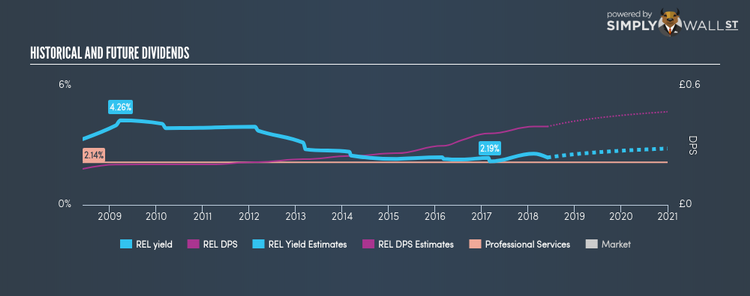Is RELX PLC (LON:REL) A Smart Choice For Dividend Investors?

There is a lot to be liked about RELX PLC (LSE:REL) as an income stock, over the past 10 years it has returned an average of 3.00% per year. The company is currently worth UK£32.36B, and now yields roughly 2.38%. Should it have a place in your portfolio? Let’s take a look at RELX in more detail. See our latest analysis for RELX
5 checks you should do on a dividend stock
When assessing a stock as a potential addition to my dividend Portfolio, I look at these five areas:
Is its annual yield among the top 25% of dividend-paying companies?
Has its dividend been stable over the past (i.e. no missed payments or significant payout cuts)?
Has dividend per share risen in the past couple of years?
Does earnings amply cover its dividend payments?
Will it be able to continue to payout at the current rate in the future?
Does RELX pass our checks?
RELX has a trailing twelve-month payout ratio of 47.96%, meaning the dividend is sufficiently covered by earnings. Going forward, analysts expect REL’s payout to remain around the same level at 49.63% of its earnings, which leads to a dividend yield of 2.69%. In addition to this, EPS is forecasted to fall to £0.71 in the upcoming year. If dividend is a key criteria in your investment consideration, then you need to make sure the dividend stock you’re eyeing out is reliable in its payments. In the case of REL it has increased its DPS from £0.18 to £0.39 in the past 10 years. It has also been paying out dividend consistently during this time, as you’d expect for a company increasing its dividend levels. These are all positive signs of a great, reliable dividend stock. Compared to its peers, RELX has a yield of 2.38%, which is high for Professional Services stocks but still below the market’s top dividend payers.
Next Steps:
Taking into account the dividend metrics, RELX ticks most of the boxes as a strong dividend investment, putting it in my list of top dividend payers. Given that this is purely a dividend analysis, you should always research extensively before deciding whether or not a stock is an appropriate investment for you. I always recommend analysing the company’s fundamentals and underlying business before making an investment decision. There are three pertinent aspects you should further examine:
Future Outlook: What are well-informed industry analysts predicting for REL’s future growth? Take a look at our free research report of analyst consensus for REL’s outlook.
Valuation: What is REL worth today? Even if the stock is a cash cow, it’s not worth an infinite price. The intrinsic value infographic in our free research report helps visualize whether REL is currently mispriced by the market.
Other Dividend Rockstars: Are there better dividend payers with stronger fundamentals out there? Check out our free list of these great stocks here.
To help readers see pass the short term volatility of the financial market, we aim to bring you a long-term focused research analysis purely driven by fundamental data. Note that our analysis does not factor in the latest price sensitive company announcements.
The author is an independent contributor and at the time of publication had no position in the stocks mentioned.

 Yahoo Finance
Yahoo Finance 
